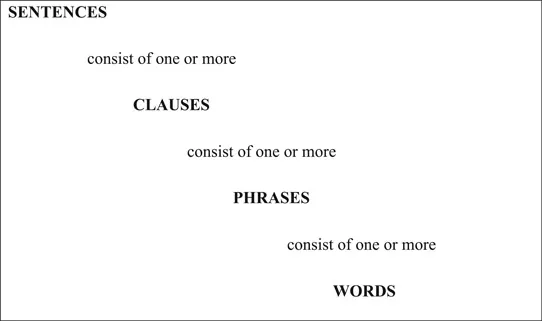
eBook - ePub
English: An Essential Grammar
Gerald Nelson
This is a test
Condividi libro
- 244 pagine
- English
- ePUB (disponibile sull'app)
- Disponibile su iOS e Android
eBook - ePub
English: An Essential Grammar
Gerald Nelson
Dettagli del libro
Anteprima del libro
Indice dei contenuti
Citazioni
Informazioni sul libro
English: An Essential Grammar is written specifically for native speakers, beginning with the basics and going on to deal with phrase, clause and sentence structure, word formation and spelling. This fully revised third edition features new material on:
-
- the structure of phrases and clauses
-
- light verbs
-
- nominal adjectives
-
- the Operator
-
- preposition to and infinitival to
-
- the four that s
-
- determiners, prepositions, and common errors
With new exercises and answers for all new sections, this Essential Grammar continues to be the ideal reference for anyone who would like to improve their knowledge of English grammar.
Domande frequenti
Come faccio ad annullare l'abbonamento?
È semplicissimo: basta accedere alla sezione Account nelle Impostazioni e cliccare su "Annulla abbonamento". Dopo la cancellazione, l'abbonamento rimarrà attivo per il periodo rimanente già pagato. Per maggiori informazioni, clicca qui
È possibile scaricare libri? Se sì, come?
Al momento è possibile scaricare tramite l'app tutti i nostri libri ePub mobile-friendly. Anche la maggior parte dei nostri PDF è scaricabile e stiamo lavorando per rendere disponibile quanto prima il download di tutti gli altri file. Per maggiori informazioni, clicca qui
Che differenza c'è tra i piani?
Entrambi i piani ti danno accesso illimitato alla libreria e a tutte le funzionalità di Perlego. Le uniche differenze sono il prezzo e il periodo di abbonamento: con il piano annuale risparmierai circa il 30% rispetto a 12 rate con quello mensile.
Cos'è Perlego?
Perlego è un servizio di abbonamento a testi accademici, che ti permette di accedere a un'intera libreria online a un prezzo inferiore rispetto a quello che pagheresti per acquistare un singolo libro al mese. Con oltre 1 milione di testi suddivisi in più di 1.000 categorie, troverai sicuramente ciò che fa per te! Per maggiori informazioni, clicca qui.
Perlego supporta la sintesi vocale?
Cerca l'icona Sintesi vocale nel prossimo libro che leggerai per verificare se è possibile riprodurre l'audio. Questo strumento permette di leggere il testo a voce alta, evidenziandolo man mano che la lettura procede. Puoi aumentare o diminuire la velocità della sintesi vocale, oppure sospendere la riproduzione. Per maggiori informazioni, clicca qui.
English: An Essential Grammar è disponibile online in formato PDF/ePub?
Sì, puoi accedere a English: An Essential Grammar di Gerald Nelson in formato PDF e/o ePub, così come ad altri libri molto apprezzati nelle sezioni relative a Lingue e linguistica e Lingue. Scopri oltre 1 milione di libri disponibili nel nostro catalogo.
Informazioni
Chapter 1
Introducing sentence structure
1.1 The constituents of a sentence
Consider the following sentence:
My father retired when he was sixty.
The sentence consists of seven words in a specific order. However, it is not simply a sequence of seven individual words. Instead, certain words ‘go together’ to form meaningful units, as follows:
[My father] [retired] [when he was sixty].
One of these units (retired) consists of just one word, while the others are multi-word combinations. Regardless of their length, however, these are the basic ‘building blocks’ of the sentence, and they are known in grammar as the constituents of the sentence. A constituent is a word or a string of words that behaves grammatically and semantically as a unit.
So our sentence consists of seven words but only three constituents. Each constituent has its own grammatical function: my father, for example, functions as the Subject (1.4) and when he was sixty functions as an Adjunct (1.8). Every constituent has a complete meaning in itself, and for that reason, every constituent (except the verb) can be replaced by a single word:
[My father] [retired] [when he was sixty]. → [He] [retired] [then].
Similarly:
[After the robbery], [the thieves] [drove] [to a safe house]. → [Then], [they] [drove] [there].
[The postman] [left] [the package] [on my doorstep]. → [He] [left] [it] [there].
[Paul] [married] [his girlfriend] [last August]. → [He] [married] [her] [then].
When you begin analysing the structure of a sentence, it is useful to apply this One-word Substitution Test, because it provides a useful initial overview of the sentence constituents.
1.2 The Grammatical Hierarchy
In grammar, there are only three types of constituents: words, phrases, and clauses. We will discuss words in Chapter 2, phrases in Chapter 3, and clauses in Chapter 4.
The Grammatical Hierarchy (Figure 1.1) provides a very useful summary of how these three types of constituents go together to form a sentence.
Words are at the bottom of the Hierarchy, and for many people, this is the most familiar area of grammar. Most people learn about word classes (nouns, verbs, adjectives, etc) early in their school careers, but do not continue their studies to look at how those words combine to form phrases and clauses. This is unfortunate, since the step from word level to phrase level is actually a very short one. For example, dog is a noun, but the dog, the little dog, and the little dog that I love are noun phrases (3.6). Similarly, happy is an adjective, while very happy and very happy to see you are adjective phrases (3.4).

Figure 1.1
The word-based approach to grammar – looking at word classes only – leads to a ver...